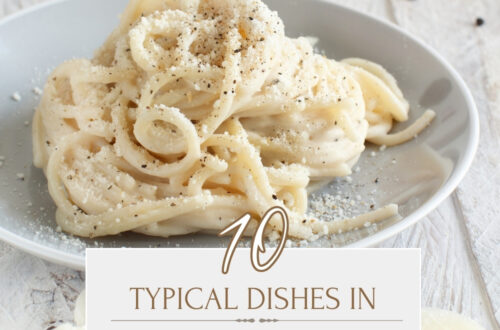10 Must-Try Dishes in Piedmont + Wine and Cheese Guide
Piedmont became my second home, when I moved here a few years ago. Living here, I quickly realized that food in Italy isn’t just about eating, but about ingredients, patience, and a deep respect for tradition.
If Tuscany is all about rustic simplicity and sun-drenched flavors, Piedmont offers a different but equally captivating culinary experience. Nestled in the northwest of Italy, Piedmont is a region where food and wine are elevated to an art form. It’s the land of truffles, rich pastas, slow-cooked meats, exceptional rice dishes and one of the best wines in the world. You can taste the refined influence of the Savoy court.
If you’re planning a visit to this beautiful region, make sure you come hungry. Here are 10 Must-Try dishes (and drinks!) you need to try in Piedmont.

10 Must-Try Dishes in Piedmont
1. Vitello Tonnato
Vitello Tonnato might sound like an unusual pairing at first—tender veal with a silky tuna and caper sauce, but trust me, it just works. This dish is a staple on restaurant menus all over Piedmont, served as a classic antipasto that locals never get tired of.
The combination is surprisingly light, packed with umami, and completely addictive. In Piedmont, you’ll find it at family gatherings, Sunday lunches, and festive tables, where it’s been a favorite for generations.
2. Battuta di Fassona
Another favorite antipasto across the region, Battuta di Fassona is similar to steak tartare but with a uniquely Piemonte twist. It is made from high-quality Fassona beef, finely chopped and served raw with olive oil, lemon juice, and sometimes truffle. The simplicity of this dish highlights the exceptional quality of the meat.
3. Agnolotti del Plin
Piedmont’s answer to ravioli, Agnolotti del Plin are small, delicate pasta parcels traditionally filled with a mix of veal, pork, and rabbit. They’re often served in a light butter and sage sauce or in a rich meat reduction. The name “plin” means “pinch,” referring to the technique used to seal these delicious bites.
4. Tajarin al Tartufo
Tajarin is one of Piedmont’s most beloved pastas—thin, delicate strands made with an egg-rich dough that gives them their signature golden color. Unlike other pastas, which might use just a few yolks, traditional tajarin recipes call for dozens, creating a silky texture. You’ll find it on menus across the region, but the best way to enjoy it is the simplest. Tossed with butter and blanketed in fragrant white truffle.
If you’re visiting in autumn, especially during Alba’s famous truffle season, where the truffle fair takes places, this dish is an absolute must.
5. Rice
Piedmont is one of Italy’s largest rice-producing regions, particularly in the flatlands of Vercelli and Novara, where rice paddies stretch as far as the eye can see (and mosquitos rule the world). Unlike other parts of Italy where pasta dominates, here, rice is just as much a staple, and the region’s risottos are some of the best you’ll find.
Risotto al Barolo is perhaps the most elegant example, made by slowly cooking rice with a generous amount of the region’s famous Barolo wine. The result is a rich, deep-colored risotto with an intense, almost velvety flavor.
Then there’s Panissa, a dish deeply rooted in the traditions of Vercelli. This rustic, comforting risotto is made with Carnaroli rice, slowly cooked with beans, lard, fat salami, red wine (usually Barbera), and broth, then finished with a generous grind of black pepper. Originally a hearty meal for rice field workers, it’s still a favorite in traditional trattorias, especially in the colder months when you need something warming and satisfying.
6. Bagna Cauda
The name Bagna Cauda means in the Piemonte’s dialect “hot bath,” which is exactly what it is. A warm, velvety mixture of garlic, anchovies, wine, and olive oil, sometimes enriched with butter or a splash of milk to mellow out the intensity. It’s a rustic, bold dish, originally created by farmers who needed something hearty and flavorful to enjoy after long days in the fields.
It is meant to be shared, savored, and lingered over, served with raw and cooked vegetables for dipping.
7. Brasato al Barolo
If you love slow-cooked, melt-in-your-mouth meats, Brasato al Barolo will be your new favorite. This dish is all about patience. It is a cut of beef (typically chuck or brisket) is slowly braised for hours in Barolo wine, along with onions, carrots, celery, garlic, and aromatic herbs like rosemary and bay leaves. As it simmers, the meat soaks up the deep flavors of the wine, turning fork-tender and intensely flavorful.
For the full experience, enjoy it with a glass of the same Barolo wine, whose bold tannins and notes of cherry, spice, and earth perfectly complement the dish.
8. Bonet
Piedmont’s most famous dessert, Bonet, is a luscious chocolate and amaretti pudding with a hint of rum. It’s similar to a crème caramel but richer, with a distinctive nutty undertone from crushed amaretti biscuits. Perfect with a coffee or a small glass of sweet wine.
9. Torta di Nocciole
Piedmont is world-famous for its hazelnuts, considered among the best in the world. The Tonda Gentile delle Langhe, the region’s prized variety, is known for its delicate flavor, fine texture, and natural sweetness.
One of the best ways to enjoy them is in Torta di Nocciole, a simple yet irresistible hazelnut cake. Traditionally made without flour, this rustic dessert lets the rich, toasty flavors of the nuts shine through, often enhanced with a touch of honey or a splash of rum. Some versions are served plain, while others are paired with zabaione, a silky egg-based dessert wine cream, or a drizzle of dark chocolate.
10. Gianduja
As I mentioned before, hazelnuts play a very important role in this region. If you didn’t know, Piedmont is the birthplace of Nutella, the iconic chocolate-hazelnut spread created by Ferrero in Alba.
Its origins trace back to Gianduja, a smooth blend of chocolate and hazelnuts that was first developed in the early 19th century when cocoa was scarce. This invention laid the foundation for countless chocolate-hazelnut treats, from pralines to spreads.
When you’re in Turin, do yourself a favor and try Gianduiotti, those little gold-wrapped chocolate-hazelnut pralines you’ll see in every pastry shop. They’re smooth, rich, and melt instantly on your tongue. Heaven in mouth!

The Wine
Piedmont is a paradise for wine lovers, home to some of the world’s most esteemed wines.
Barolo: Known as the “King of Wines,” Barolo is made from Nebbiolo grapes and requires extensive aging. It is bold, tannic, and complex, with aromas of rose, tar, and red fruit. Aged for at least three years (five for Riserva), this is a wine to savor alongside rich meat dishes like Brasato al Barolo.
Barbaresco: Often called the “Queen of Wines,” Barbaresco is also made from Nebbiolo but is typically more elegant, fruit-forward, and slightly less tannic than Barolo. It pairs beautifully with Agnolotti del Plin and aged cheeses.
Barbera: With its high acidity and juicy red fruit flavors, Barbera d’Alba and Barbera d’Asti are versatile and easy to drink, pairing well with pasta dishes like Tajarin al Tartufo.
Dolcetto: A softer, fruitier red wine, Dolcetto is the everyday Piedmonts’ wine. Despite its name (“little sweet one”), it is dry and pairs wonderfully with Bagna Cauda and cured meats.
Asti Spumante & Moscato d’Asti: If you love sparkling wines, Piedmont has you covered. Asti Spumante is fully sparkling, while Moscato d’Asti is lightly fizzy, aromatic, and slightly sweet, making it the perfect match for desserts after a hearty meal.

Cheese from Piedmont
Castelmagno: One of the oldest and most prized cheeses of the region, Castelmagno has a firm texture that softens with age, developing an intense, slightly spicy flavor. Traditionally, it is crumbled over risotto or pasta, but it can also be enjoyed on its own with a drizzle of honey or a glass of Barbaresco.
Toma Piemontese: A semi-soft cheese with a creamy, buttery taste and a mild aroma. It comes in two varieties: one made from cow’s milk and another from mixed milk, offering a delicate yet satisfying flavor that pairs well with fresh bread and Dolcetto d’Alba.
Robiola di Roccaverano: This artisanal goat cheese has a smooth, creamy texture with a slightly tangy and nutty taste. It is one of the few Italian cheeses made entirely from goat’s milk and is best enjoyed fresh, spread on crusty bread, or drizzled with olive oil. Pairs wonderfully with Barbera d’Asti.
Bra: Named after the town of Bra, this cheese comes in two styles: Bra Tenero (young, soft, and delicate) and Bra Duro (aged, firmer, and more intense in flavor). It is often used in cooking or you can pair it with a Dolcetto d’Alba.
Gorgonzola Piemontese: The star of the cheeses. While Gorgonzola is produced in both Lombardy and Piedmont, the Piedmontese version is known for its creamier, more delicate texture. It comes in two main varieties: Dolce (mild, creamy, and slightly sweet) and Piccante (firmer, sharper, and more aged). Both are excellent paired with pears, nuts. AS for the wine, Gorgonzola dolce pairs good with a Riesling, while Gorgonzola piccante with red wine like Barolo or Barbaresco.

Piedmont’s cheeses are as varied and rich as its wines, and a must-try, if you are a food lover visiting the region! When exploring Piedmont, venture beyond the cities and into the countryside. Visit the truffle markets of Alba, take a winery tour in Langhe or Monferrato, the rolling hills of the north, and don’t forget to indulge in hazelnut-based pastries. Piedmont is where Italy’s finest hazelnuts come from!
Writing this has me craving everything from a plate of Agnolotti to a glass of Barolo!
Have you tried any of these dishes, or is there something unforgettable you’ve eaten in Piedmont? I’d love to hear about the flavors that left a mark on you. Share your foodie experiences in the comments!
Eat with curiosity, travel with passion, and always save room for dessert. Buon appetito!


